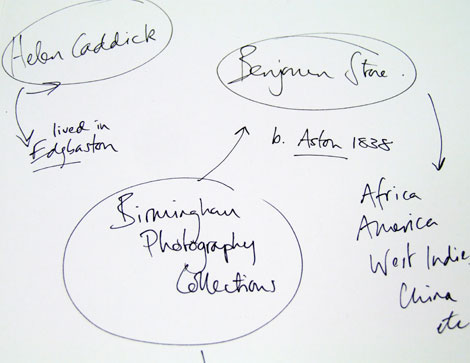
Create Your Own Archive
Creative Problem Solving
Further Suggestions on Making Notes
Create your own Archive
The idea of ‘making notes’ while doing research seems obvious enough. You need to keep a record of all the important pieces of information you have discovered - your notes, photocopies, photographs, journals, books, records, etc. Creating your own archive of gathered knowledge is an important practical and creative task. Use a filing or folder system which works best for you. Alphabetical systems can order and store your notes for easy recall (Caddick, Helen; Stone, Benjamin). Or you could use theme trees: Birmingham Photographers (men); Birmingham Photographers (women). However, the more information you gather, the more you may need to use detailed sub-categories for your notes, such as ‘Benjamin Stone and Africa’; ‘Helen Caddick in the Middle East’. This will help you retrieve information more easily instead of being lost in a room with mountainous piles of menacing random papers.
<return to top>
Creative Problem Solving
But making notes during research is also about playing with ideas. It means keeping a track of your thoughts, ideas, contacts, impressions and emotions as they unfold (often spontaneously) through your work. These are often vital when you are putting together the texts for your exhibition or learning package. Constantly sketching out rough ideas and drawing bubble charts and flow diagrams can help you hone your project into shape. It enables you to visualise the real direction and substance of your intended learning package, work out solutions to crucial problems, and create clear sections for your work.
Creative note taking, sketch charts, maps and flow diagrams were vital in both recording the research needed to form the subject matter of Questions of Travel as well as in coming up with the final ‘structure’ of the exhibition. It was only when the notes on Benjamin Stone and notes on Helen Caddick were brought together that the close connections and contrast between the two people became clear. Looking again at the basic facts (ie. both photographers from Birmingham, working around the late 19th century, whose work now forms important historical collections in Birmingham Central Library) and reviewing the critical readings that had been done, the basic ideas were sketched and re-sketched out to draw the strands of the project together more closely.
<return to top>
Further Suggestions on Making Notes
- Answers to problems come at any moment at any place at any time: always keep a pen and notepad handy.
- Never, ever, enter a library without pencil and paper.
- Write down ideas as they come to you.
- Sketch out overviews of what information will fit in each section of your learning package.
-
Always record the library reference and location numbers of books you are using.
- Always write down the publisher, year, author and page numbers you have used.
- Use notes to see links between different subjects.
- Draw a large map of your learning unit to help you visualise what will go where.
- If you find out some interesting information that does not fit your project, make a note. It could start your next project.
- Start your own personal library of photocopies, notes, reference numbers, interesting facts, and vital information.
- Keep going back over the notes you have already made to see new perspectives on what you have been learning.
<return to top>
Author: Dr Andy Green
Image: Dr Andy Green
|
|
|